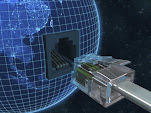The data link layer frame includes source and destination addresses, data length, start signal or indicator and other related Ethernet information to enhance communication. This layer's main responsibility is to transfer data frames between nodes over a network.
The data link layer is used for the encoding, decoding and logical organization of data bits. Data packets are framed and addressed by this layer, which has two sub-layers.
The data link layer's first sub-layer is the media access control (MAC) layer. It is used for source and destination addresses. The MAC layer allows the data link layer to provide the best data transmission vehicle and manage data flow control.
The data link layer's second sub-layer is the logical link control. It manages error checking and data flow over a network.
Provides for the reliable transfer of data cross a physical link.
Frames
Physical address
Network topology
Line discipline
Synchronization
Error control
Flow control
The Data Link layer performs two basic services:
Allows the upper layers to access the media using techniques such as framing
Controls how data is placed onto the media and is received from the media using techniques such as media access control and error detection
Layer 2 defines how data is formatted for transmission and how access to the physical media is controlled. These devices also provide an interface between the Layer 2 device and the physical media. Some common examples are a NIC installed in a host, bridge, or switch.
The data link layer is used for the encoding, decoding and logical organization of data bits. Data packets are framed and addressed by this layer, which has two sub-layers.
The data link layer's first sub-layer is the media access control (MAC) layer. It is used for source and destination addresses. The MAC layer allows the data link layer to provide the best data transmission vehicle and manage data flow control.
The data link layer's second sub-layer is the logical link control. It manages error checking and data flow over a network.
Provides for the reliable transfer of data cross a physical link.
Frames
Physical address
Network topology
Line discipline
Synchronization
Error control
Flow control
The Data Link layer performs two basic services:
Allows the upper layers to access the media using techniques such as framing
Controls how data is placed onto the media and is received from the media using techniques such as media access control and error detection
Layer 2 defines how data is formatted for transmission and how access to the physical media is controlled. These devices also provide an interface between the Layer 2 device and the physical media. Some common examples are a NIC installed in a host, bridge, or switch.


Post a Comment